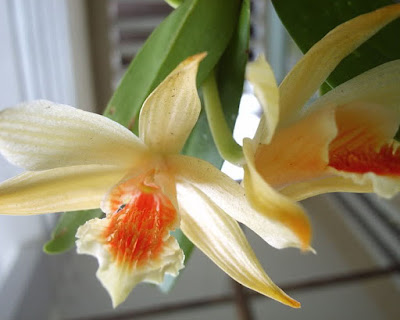Dendrobium heterocarpum is one of the most widespread of all Dendrobium species. Natural habitats include southwestern India and the Himalayan region from northwestern India to southwestern China.
Dendrobium heterocarpum, also called as The Different Fruit Dendrobium, Callista aurea, Callista heterocarpa, Dendrobium atractodes, Dendrobium aureum, Dendrobium aureum var. pallidum, Dendrobium heterocarpum var. henshalii, Dendrobium minahassae, Dendrobium rhombeum, is a species of the genus Dendrobium. This species was described by Wallich ex Lindley in 1830.
IDENTIFY DENDROBIUM HETEROCARPUM
Dendrobium heterocarpum is one of the most widespread of all Dendrobium species. Natural habitats include southwestern India and the Himalayan region from northwestern India to southwestern China, including the tropical valleys of Sikkim and Assam, and Patkai and Khasi (Khasia) Hills. Range of distribution extends through Burma, Thailand, Cambodia, Laos, Vietnam to the Philippines, where it occurs on the island of Luzon at an altitude of 1300-1500 m. To the south the habitat extends through Malaya, Sumatra, Java and North Sulawesi (Celebes) to Sri Lanka Lanka and Sunda Islands. In Thailand, grow at heights of 600-1700 m. In India, they can be found very low, at 100 m in cooler regions, but in warmer areas they can grow up to 1,300 m. They usually grow on trees in forest glades.
It is a small to giant sized, hot to cool growing epiphyte, which reaching 15-150 cm in height, with fusiform or subcylindrical, erect or pendulous, many noded, yellow with age, 15-150 cm long stems with tubular basal sheaths carrying deciduous, ligulate or oblong-lanceolate, acute to obtuse, 10-13 cm long leaves.
The Different Fruit Dendrobium blooms in the winter and spring on a lateral, short, few to several, long-lived, fragrant or not, flowered inflorescence that arises from the nodes on 2 to 3 year old leafless canes. The flowers are 3.5-8.0 cm in diameter. The outer whorls are slender and the lip and petals of the inner whorl are wider. These beautiful flowers can be white, pale yellow or amber. Narrow, wavy lip with a sharp tip is slightly 3-spline. On the inside is gold-brown with red or brown veins. The disk is velvety and with age becomes deep gold-yellow.
DENDROBIUM HETEROCARPUM CARE AND CULTURE
Dendrobium heterocarpum are happy to bloom and can bloom at any time of the year except the beginning of summer. In Sulawesi, they bloom at the end of autumn and at the beginning of winter. From other areas, they bloom in spring. They usually bloom in very bright light, until the trees cover the leaves. It is a popular plant and easily adapts to the created conditions.
Light:
Dendrobium heterocarpum needs a light level of 30000-40000 lux. The light should be naturally filtered from spring to autumn, but its level should be as high as the plant can tolerate without scalding the leaves.
Temperature:
The average temperature of the summer day is 25-26 ° C, the night 17-18 ° C, giving a daily difference of 7-8 ° C. In spring, the average day temperature is 29-31 ° C, the night 11-18 ° C, giving a daily difference of 11-20 ° C. In winter the average day temperature is 23-30 ° C, night 8-11 ° C, giving a daily difference of 14-20 ° C.
Humidity:
From summer to autumn, The Different Fruit Dendrobium need the humidity of 80-85%, and in winter it drops to 60-70%. During 2 spring months, however, the conditions are very dry and the humidity drops to almost 50%.
Substrate, growing media and repotting:
Dendrobium heterocarpum is easier to grow mounted on tree ferns or cork or in hanging, small pots or baskets. When growing in pots, any loose, quickly drying media is recommended. Repotting is best done at the beginning of spring, when new roots begin to grow. Flowers may appear on 3-year-old shoots, so they should not be removed when repotting.
Watering:
Precipitation is very abundant during the growing season, but winters are very dry. Dendrobium heterocarpum require frequent and abundant watering during the growing season, but when new growths reach maturity in autumn, the amount of water should be gradually reduced.
Fertilizer:
It is recommended to apply a 1/4-1/2 dose of orchid fertilizer weekly. From spring to mid-summer, it is preferable to use high-nitrogen fertilizer, and then to the end of autumn, high phosphorus fertilizer.
Rest period:
Water should be reduced from the end of autumn to spring. For most of winter, Dendrobium heterocarpum should dry out between waterings, but they can not be completely dry for too long. Occasional morning fogging between watering will protection the plant against excessive drying. In the period of 1-2 months at the end of winter, however, the amount of water should be limited to morning fogging. Fertilization should be reduced or eliminated until new growths appear in the spring.















COMMENTS